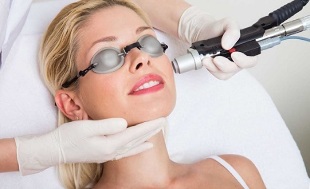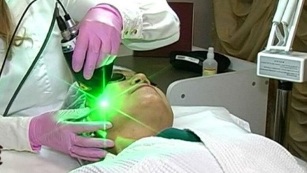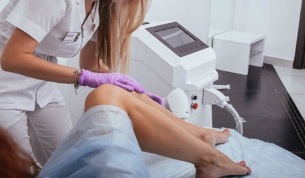
Are there facial rejuvenation methods without radical interventions like injections or even a scalpel?
Of course, such methods exist and are successfully applied in practice, pushing back invasive techniques.
Modern cosmetology is intensively developing new and effective technologies based on minimal damage to the skin and reduction of pain during the procedure.
Today we will tell you how laser facial rejuvenation occurs using a diode laser, what is the fundamental difference with other types of lifting, as well as we will evaluate the advantages and disadvantages of the method.
Diode laser resurfacing
Laser techniques are widely used by cosmetologists for various purposes: peeling, waxing, biorevitalization, tattoo lightening, and much more.
In general, laser procedures are divided into two types. That is, either with damage to the skin structures or in a more gentle way. The method of laser facial rejuvenation also refers to modern thrifty techniques.
How the diode laser works
Due to the minimal thermal effect on the skin, the diode laser is considered a cold laser for its properties. Heating of the skin is present, but the essence of the method is that it does not give the feeling of hellish overheating on the surface, as with laser resurfacing.
The advantage of a diode laser is that it can penetrate deep enough into the skin, retaining its properties without generating residual heat.
By itself, the laser beam from a diode device has a wavelength in the range of 810-940nm and, by leaking imperceptibly inward, causes the following response from your skin:
- awakens cells that, seeing a ray shining on them, begin to function better.
- stimulates the production of collagen and elastin, substances without which the skin cannot be firm and radiant.
- stimulates regeneration processes: activated cells begin to notice their weaknesses and activate their own mode of renewal.
This is the main difference between this technique and mesotherapy, including biorevitalization: the effect of the procedure occurs due to the targeted production of young cells stimulated by the laser, and not the saturation of the middle layers of the skinwith drugs. As a result, the skin is visibly fresher and younger.
Indications and contraindications of laser facial rejuvenation
Now that we have an idea of how a diode laser works, let's look at the characteristics that need to be considered before we decisively rush to the esthetician for a beauty prescription.
So the absolute prompts for the procedure can be:
- decrease in turgor;
- wrinkled mesh;
- mimic wrinkles;
- hyperpigmentation;
- scars;
- acne.
Contraindications are all common exceptions to visiting the aesthetic medicine office:
- Blood diseases: thrombocytopathy, thrombosis, hemophilia, von Willebrand disease and others.
- cardiovascular pathology;
- systemic organ diseases;
- diabetes of any kind; Hereditary autoimmune
- : lupus, rheumatoid inflammation, vasculitis;
- both mother and baby are at risk during pregnancy and lactation;
- sensitivity to light or fresh tan
There is a very important point to consider before performing a laser procedure.
The laser beam emitted by the diode device mainly contacts and binds to the skin pigment, melanin, under normal conditions and the adequacy of the processes taking place, this cannot cause any harm. But, if you are concerned about questionable neoplasms on your body, suspicious moles and lumps, you should inform your doctor.

Since interference with the metabolism of melanin, with certain risks of predisposition to oncology, can lead to a malignant course of the process.
And still few people know and they are rarely warned that many groups of drugs have the effect of photosensitization in side effects, that is, they increase the sensitivity of the skin to ultraviolet radiation.
These are broad categories of drugs: contraceptives, antibiotics (especially fluoroquinolones and tetracyclines), antipsychotics, cardiology, antifungals, diuretics, and many others; In certain circumstances, even B vitamins can cause an unwanted reaction.
Therefore, you should inform the cosmetologist about taking any medication, indicating the dosage and duration of use. This can help you in many ways to prevent the development of negative consequences, such as red skin and sunburn.
Advantages and disadvantages of laser resurfacing
Any medical manipulation definitely has its pros and cons. Laser resurfacing is no exception. And before making a responsible decision, you need to carefully evaluate all the pros and cons.
Advantages that catch the eye:
- does not disturb the process.
- is relatively safe in the absence of contraindications.
- Your own cells start to work better without the use of drugs.
- can be used on the most delicate areas of the face: the skin around the eyes.
- At the end of the course, the skin not only looks younger, but also acquires a special tenderness and radiance that cannot fail to delight.
- does not require special preparation and rehabilitation, the main thing is to avoid exposure to ultraviolet rays on exposed skin for a while.
Disadvantages also occur:
- The effect of the procedure does not appear immediately, but after about 3-4 sessions, depending on the initial state of the skin.
- periodically it is necessary to maintain the results obtained with new courses.
- The equipment on which the technique is performed has a high cost, and the doctor performing the procedure must have excellent qualifications, so you should not expect low prices for this service.
- strict attention to possible contraindications.
Interesting fact.Diode laser is used in cosmetology not only for the purpose of rejuvenation, but has found more widespread use as a way to remove hair growthunwanted in body.

Laser hair removal is a fast and effective way to remove unwanted hair from almost any part of the body. For some cosmetic procedures, you can achieve smooth, smooth skin. The procedure is safe and harmless.
But for hair removal, a completely different length and intensity of the beam is used, so do not worry that when you come for youth, you risk having a face without eyelashes, eyebrows and a cheerful gun on the edge of thescalp.
The device is customizable and adjustable, which is perfect for two fundamentally different cosmetic procedures.
At what age can laser resurfacing be performed?
Life makes us frown, smile, squint mischievously, and over time, the skin tires of reverting to its original smooth format.
Laser resurfacing restores natural elastic functions, helps connective tissue cells work better, stimulates protection against external stimuli.
In general, manipulation deserves attention, as it gives you the opportunity to enjoy your beauty and youth without pain.
The procedure is recommended from 18 years to treat acne, and in the last period from 25 to 40 years to maintain the functioning of cells and youthful skin. An experienced esthetician will always be able to help you make the right decision to achieve your goal and understand all the nuances.











